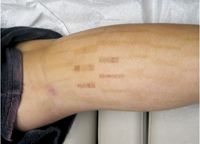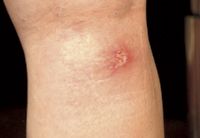- General Dermatology
- Eczema
- Chronic Hand Eczema
- Alopecia
- Aesthetics
- Vitiligo
- COVID-19
- Actinic Keratosis
- Precision Medicine and Biologics
- Rare Disease
- Wound Care
- Rosacea
- Psoriasis
- Psoriatic Arthritis
- Atopic Dermatitis
- Melasma
- NP and PA
- Skin Cancer
- Hidradenitis Suppurativa
- Drug Watch
- Pigmentary Disorders
- Acne
- Pediatric Dermatology
- Practice Management
- Prurigo Nodularis
Article
Doing the laser-tissue tango: Understanding relationship reduces complications
Author(s):
Regardless of the physician's skill and experience, complications can arise with laser surgery. Knowing how to deal with them lessens problems for the doctor and patient, experts say.

Key Points

"There is no such thing as a cookbook formula for laser surgery," says David Goldberg, M.D., J.D., clinical professor of dermatology and director of laser research, Mount Sinai School of Medicine, New York.
Following a specific formula is not the way to avoiding complications, Dr. Goldberg says. "If physicians think in terms of laser-tissue interaction and familiarize themselves with (desirable) endpoints, they'll reduce their complication rate to near zero, whether they're treating wrinkles or blood vessels or hair removal," he says.
Fractionated laser delivery is associated with many fewer complications than traditional carbon dioxide lasers, says Christopher Zachary, M.D., professor and chairman, department of dermatology, University of California, Irvine, Calif. But, he adds, it is important for physicians to recognize that complications can - and do - occur with fractional lasers.

"We probably have been pushing the envelope because we want to get the best possible outcome for our patients, and with the early use of new devices, we push the boundaries to see know how far we can go safely," he says.
Dr. Zachary says it's important not to promise too much, especially with patients who have excessive skin laxity or significant acne scarring.
"I think one treatment actually primes the skin, so if you treat it again about four weeks later, you'll get a more effective result, and you'll get faster healing and fewer complications," he adds.
Dr. Zachary suggests that many complications are the result of associated infection.
"When I treat patients with fractionated devices - unlike most of my peers in the U.S. - I put them not only on antiviral medications, but I give them full doses of broad-spectrum antibiotics and anti-candida agents as well," Dr. Zachary says.

Avoiding problems
Avoiding complications by getting a feel for how tissue reacts to various lasers and laser settings is one method of practicing successful laser surgery. An equally critical component is reacting swiftly and appropriately when complications do occur.
Including the second strategy is what separates the dermatologists who remain in their patients' good graces from those who don't, says Michael H. Gold, M.D., assistant clinical professor, Vanderbilt University Medical Center, Nashville, Tenn.
"No matter how good you are, no matter how long you've been in practice, you are going to see complications and adverse events. When you don't know how to properly take care of them, that's when problems can begin for the dermatologists," Dr. Gold says.






